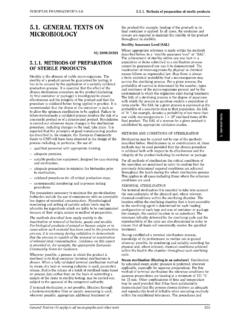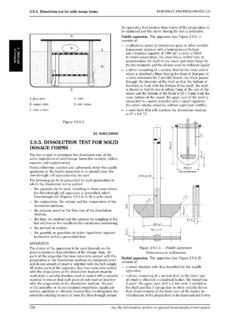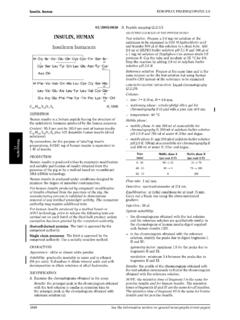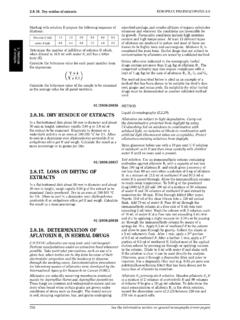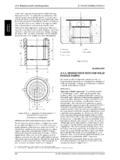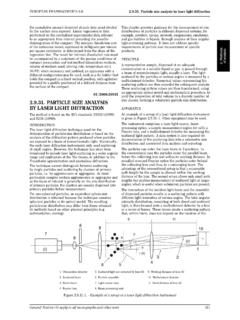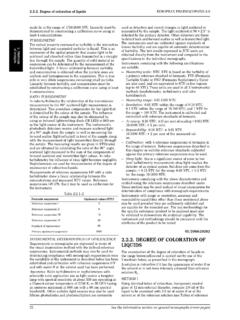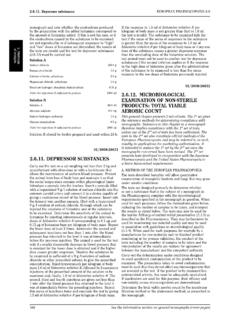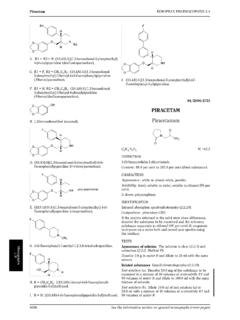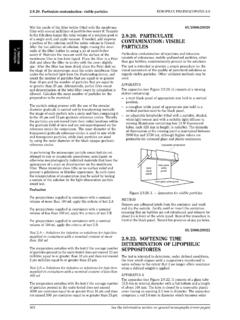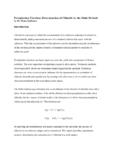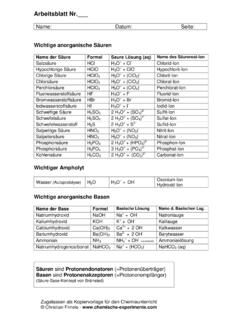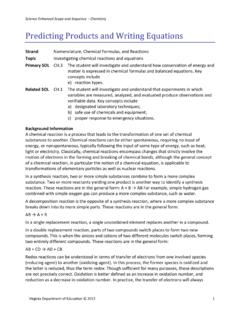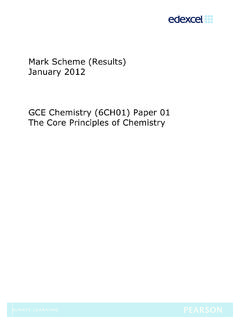Transcription of 2.2.3. POTENTIOMETRIC DETERMINATION OF pH - …
1 POTENTIOMETRIC DETERMINATION of pHEUROPEAN PHARMACOPOEIA -Reference solutions GYVolumes in millilitresReferencesolutionStandard solution GY Hydrochloric acid(10 g/l HCl) -Reference solutions RVolumes in millilitresReferencesolutionStandard solution R Hydrochloric acid(10 g/l HCl) Method I, the reference solutions may bestored in sealedtubes of colourless, transparent, neutral glass of 12 mmexternal diameter, protected Method II, prepare the reference solutions immediatelybefore use from the standard POTENTIOMETRICDETERMINATION OF pHThe pH is a number which represents conventionally thehydrogen ion concentration of an aqueous solution. Forpractical purposes, its definition is an experimental pH of a solution to be examined is related to that of areference solution (pHs) by the following equation:in whichEis the potential, expressed in volts, of the cellcontaining the solution to be examined andEsis thepotential, expressed in volts, of the cell containing thesolution of known pH (pHs),kis the change in potentialper unit change in pH expressed in volts, and calculatedfrom the Nernst Values of k at different temperaturesTemperature ( C)k(V) POTENTIOMETRIC DETERMINATION of pH is made bymeasuring the potential difference between 2 appropriateelectrodes immersed in the solution to be examined: 1 ofthese electrodes is sensitive to hydrogen ions (usually aglass electrode) and the other is the reference electrode (forexample, a saturated calomel electrode).
2 Apparatus. The measuring apparatus is a voltmeter with aninput resistance at least 100 times that of the electrodes is normally graduated in pH units and has a sensitivitysuch that discrimination of at least pH unit or at V may be Unless otherwise prescribed in the monograph, allmeasurements are made at the same temperature (20-25 C).Table shows the variation of pH with respect totemperature of a number of reference buffer solutionsused for calibration. For the temperature correction,when necessary, follow the manufacturer s apparatus is calibrated with the buffer solution ofpotassium hydrogen phthalate (primary standard) and1 other buffer solution of different pH (preferably oneshown in Table ). The pH of a third buffer solutionof intermediate pH read off on the scale must not differ bymore than pH unit from the value corresponding tothis solution. Immerse the electrodes in the solution to beexamined and take the reading in the same conditions asfor the buffer the apparatus is in frequent use, checks must becarried out regularly.
3 If not, such checks should be carriedout before each solutions to be examined and the reference buffersolutions must be prepared usingcarbon dioxide-freewater OF REFERENCE BUFFER SOLUTIONSP otassium tetraoxalate M. Dissolve g ofC4H3KO8,2H2 Oincarbon dioxide-free water Rand dilute ml with the same hydrogen tartrate, saturated at 25 excess of C4H5KO6vigorously withcarbon dioxide-freewater Rat 25 C. Filter or decant. Prepare immediatelybefore dihydrogen citrate M. Dissolve gof C6H7KO7incarbon dioxide-free water Rand dilute ml with the same solvent. Prepare immediately hydrogen phthalate ,previouslydriedfor1hat110 2 C,incarbondioxide-free water dihydrogen phosphate M + disodiumhydrogen phosphate M. Dissolve g of KH2PO4and g of Na2 HPO4,bothpreviouslydriedfor2hat120 2 C,incarbon dioxide-free water Rand dilute ml with the same dihydrogen phosphate M + disodiumhydrogen phosphate M. Dissolve g of KH2PO4and g of Na2 HPO4,bothpreviouslydriedfor2hat120 2 C,incarbon dioxide-free water Rand dilute ml with the same tetraborate ,10H2 Oincarbon dioxide-free water Rand diluteto ml with the same solvent.
4 Store protected fromatmospheric carbon the information section on general monographs (cover pages)EUROPEAN PHARMACOPOEIA Relative densityTable pH of reference buffer solutions at various temperaturesTemperature( C) MPotassiumhydrogentartratesaturated at25 M+ M+ M+ MCalciumhydroxide,saturatedat 25 CC4H3KO8,2H2OC4H5KO6C6H7KO7C8H5KO4KH2PO4 +Na2 HPO4KH2PO4+Na2 HPO4Na2B4O7,10H2 ONa2CO3+NaHCO3Ca(OH) + + (1) pH variation per degree carbonate M + sodium hydrogen M. Dissolve g of Na2CO3and g of NaHCO3incarbon dioxide-free water Rand dilute to ml withthe same solvent. Store protected from atmospheric hydroxide, saturated at 25 hydroxide Rwithcarbon dioxide-free water Randdecant at 25 C. Store protected from atmospheric buffer solutions in suitable chemically resistant, tightcontainers, such as type I glass bottles or plastic containerssuitable for aqueous RELATIONSHIP BETWEENREACTION OF SOLUTION,APPROXIMATE pH AND COLOUROF CERTAIN INDICATORSTo 10 ml of the solution to be examined, add ml ofthe indicator solution, unless otherwise prescribed inTable >8 Litmus paper red RBlueThymol bluesolution R( ml)Grey or violet-blueSlightly R( ml)Colourless or pinkThymol bluesolution R( ml)GreyStrongly alkaline>10 Phenolphthaleinpaper RRedThymol bluesolution R( ml) red solution RYellowPhenol redsolution R( ml)Neutral to red solution ROrange-redNeutral tophenolphtalein< R( ml)Colourless.
5 Pink or redafter adding mlof M baseAcid<6 Methyl red solution ROrange or redBromothymol bluesolution R1 YellowFaintly red solution ROrangeBromocresol greensolution RGreen or blueStrongly acid<4 Congo red paper RGreen or blue01/2008 RELATIVE DENSITYThe relative densityof a substance is the ratio of themass of a certain volume of a substance at temperaturet1tothe mass of an equal volume of water at otherwise indicated, the relative densityisused. Relative density is also commonly expressed 20, defined as the mass of a unit volume ofthe substance at 20 C may also be used, expressed inkilograms per cubic metre or grams per cubic centimetre(1 kg m 3=10 3g cm 3). These quantities are related by thefollowing equations where density is expressed in grams percubic centimetre:Relative density or density are measured with the precisionto the number of decimals prescribed in the monographusing a density bottle (solids or liquids), a hydrostaticbalance (solids), a hydrometer (liquids) or a digital densitymeter with an oscillating transducer (liquids and gases).
6 GeneralNotices(1)applytoallmonographsand othertexts25
